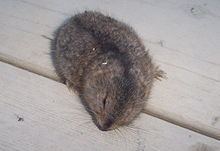Kingdom Animalia Class Mammalia Family Muridae Scientific name Lemmus trimucronatus | Phylum Chordata Order Rodentia Genus Lemmus Rank Species | |
 | ||
Similar Northern collared lemming, Collared lemming, True lemming, Siberian brown lemming, Arctic lemming | ||
The North American brown lemming (Lemmus trimucronatus) is a small North American lemming. Originally called the Siberian brown lemming (Lemmus sibiricus) they were later formed into two distinct species.
Contents
Physical characteristics
The lemmings are a brown in colour, with an reddish-brown back and rump, while the head and shoulders are grey. In the winter, the coat becomes longer and greyer. The female averages 12.5 cm (5.7 in) in length and weighs 58 g (2.4 oz), while the male averages 13 cm (5.9 in) and weighs 68 g (2.7 oz). Like other lemmings, it has small ears, short legs and a very short tail. The feet, both the soles and toes, are covered with bristles and are adapted for burrowing.
Habitat
The lemming is found in the tundra areas of northern Canada (Nunavut, Northwest Territories, Yukon), and Alaska. It is also found on the west coast of British Columbia almost as far south as Vancouver Island. They feed mainly on grass shoots and will also eat tundra grass, sedge, moss, bark, berries, lichens, and roots. Predators include most carnivores and certain birds, and some evidence suggests caribou may sometimes eat them. In years when the brown lemming is scarce, some predators, such as the Arctic fox, may be unable to reproduce.
Colonies
They live underground, in colonies, and may produce up to three litters each year, including under the snow in winter. With a gestation period of 23 days, the female will give birth from four to nine young. The brown lemming is not migratory and when overpopulated (and during mating season), they will fight amongst themselves.
Bylot Island has several wetlands with shallow polygons and many types of mosses, grasses and sedges, which suits the North American brown lemming very well for several reasons (Rochefort et al. 1996). On Bylot Island they prefer to live in the South plain of the island and mostly live in the polygon fen, also known as wetlands, which mostly supports the graminoids that they rely on for food (Bety et al. 2002). During winter brown lemmings live in insulated burrows in the ground made out of sedges and grasses (Reid et al. 2011). They make their nests in these confined burrows underground because it increases insulation and allows them to reproduce during winter (Duchesne et al. 2011). Studies on Bylot Island have shown that brown lemmings prefer to burrow under increasing snow depth rather than more dense. They believe that brown lemmings do this because the more snow depth the better energy is trapped and the number of nests increased. Deeper snow cover also protected lemmings and their nests from avian predators; mammalian predators can still forage for them but since their nests are so deep it decreases the ability of some predators to see, therefore, they are very well protected from predators (Duchesne et al. 2011; Reid et al. 2012). During summer, brown lemmings do not have the cover of snow and their territories become a lot more widespread across Bylot Island (Reid et al. 2012).
